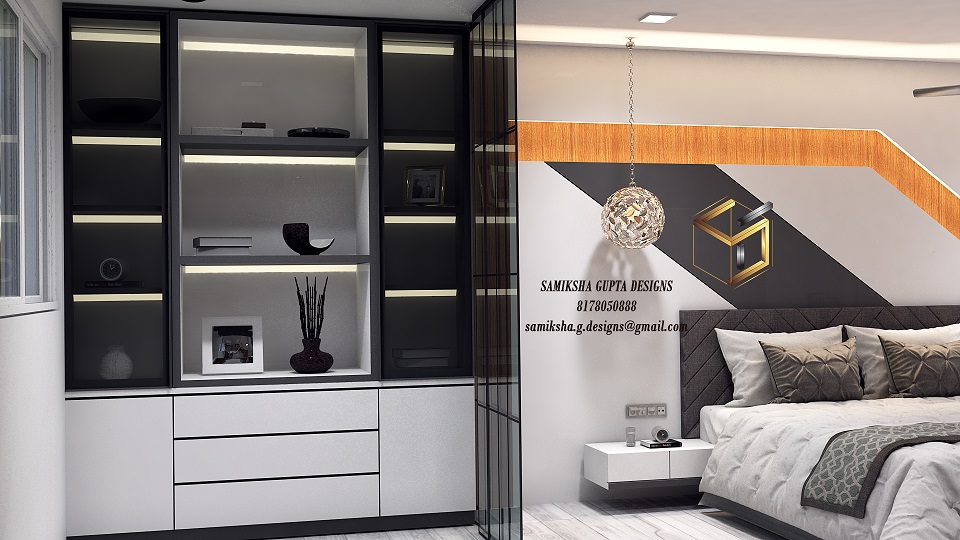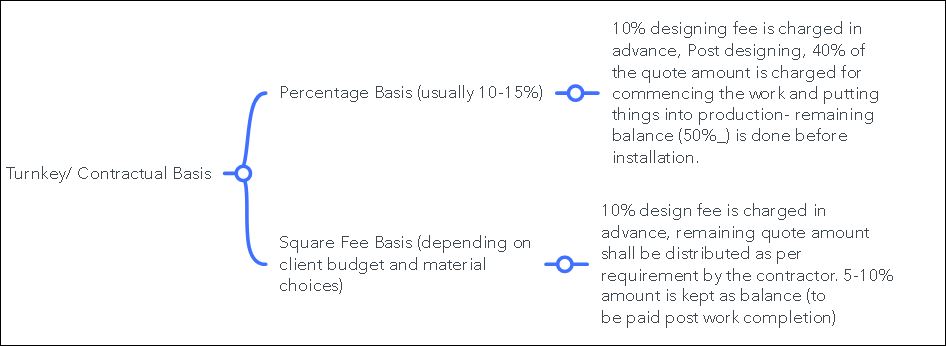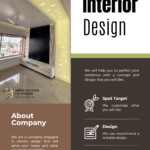Have you recently bought a new house? Are you planning to hire a professional to design your house? Do you want to revamp your old house? But struggling to find the right person to go to? Are you clueless about how Interior designers charge?
Gone are the days when people would do it themselves. Honestly, we don’t really have the time or resources to do it ourselves. Do we?
Hiring a professional Interior Designer is something that most new homeowners are considering. It’s a trend, it’s vogue these days.
People are looking for a professional who can be their “one point of contact” for home interiors. Nobody wants to deal with a number of contractors, dealers, or vendors. It’s hectic. It gets to you. You’d rather save all that energy for your own work.
However, we’re also unsure and confused about one thing.
How Much Does An Interior Designer Charge?
After all, it affects the overall Interior design cost.
This is a question that many people have in mind. Many people never get a direct answer to this. This is a question that not only people who are new to this field ask, but I personally know a lot of interior designers also who are clueless about how they should charge, what should be their payment schedules, what’s the right and feasible amount they should be charging their clients.
A lot of designers even end up losing potential clients because of this dilemma and cluelessness.
Not to worry.
In this blog, I will tell you about all the different ways in which an interior designer can model their fee structure. I will also tell you a price range (wherever applicable/feasible) depending on the scope of work the designer is taking up.
Now first, let’s look at
The Different Parameters That Decide an Interior Designer’s Cost
The interior designer fixes the rates on a variety of factors, such as:
1. Your requirements and your preferences
Every client has unique requirements. Based on this, a designer may suggest different materials and finishes for your project which directly impacts the overall cost of the project. Some people may need minimalistic design, some may want a more artistic look to their space. Some may look for high-end interiors with top-end products.
It’s not also just about the materials and finishes. It’s also about how much time the designer would need to put into your project. It may depend on whether you’re looking for modular solutions or more customized work. The designer may fix their fee based on how involved they’re going to be in the project.
2. Your budget
It’s very important for the designer to at least have some idea about how much are you planning to spend on the interiors of your new house. This is only how they can suggest the right products, materials and finishes to you.
It also happens a lot of times that people are not really sure about their budgets, since they have bought their own house for the first time or are simply unaware of many market rates. If this is the case, be open to your designer. They can probably help you decide your budget as well. They can help you understand what you can get at what price and you can then take a call on what’s on priority for you and what may go out of your budget. Once you’ve come to a figure, tell it to your designer very frankly. This will help your designer to decide their own fee for the project.
3. Material Costs
Different materials can heavily impact the project cost. While laminate is one of the most cost-effective options, PU paint or veneer can increase the project cost drastically. Also, with fluctuating market prices in these times, it can become tricky for the designers to quote you a fixed price for the project.
Every estimate comes with a validity time period and this should be discussed before finalizing the project with the designer.
4. Brands of Materials Used
Although it is always advised to go for only branded items for interior work, sometimes the designer or contractor may suggest you go for cheaper options to save on project costs. Even though branded products come with warranties, at times it’s not worth burning your pockets over items that can do without much durability. When I say items that need not be much “durable”, I mostly speak of decorative design elements/products and not essential furniture like sofas, or beds. And apparently, “brands” don’t always necessarily mean “quality”.
Your designer can help you choose the right brands for your budget and project cost. This is why hiring a designer is important. They know better. Professionals know the ins and outs. They can save you from getting fooled by brand sellers.
5. Labor Charges
Just like materials, the cost of labour can also directly impact the design cost. Different places in the country have different labour rates. While it may be skyrocketing in some cities, you can get skilled labour in any other city at very nominal rates.
Usually, it’s also advised that you go with the designer’s team for interior work even if they may cost a bit higher than local labourers. That way you get a better finishing in your project and better stakeholders.
6. Kinds of lights/fixtures used
I usually leave it in my clients’ scope. There’s a huge variety and a huge market for a variety of lights. And these are the products which are usually purchased during the finishing stage of any project. By then the client also develops a taste for décor items that they want to get for their new home.
This is something they like doing by themselves. Of course, your designer can help you out with a better selection according to the overall interior or theme of the space, but this is something that you can put your personal touch on. And because there is a huge price range for similar-looking lights, it’s only transparent that you bought it at your own end.
7. Type of the Deal- Contractual, Consultation or Turnkey
A designer’s scope of work may differ from just taking up on “consultation”, to a “contractual” basis. In case the client is looking for a more hassle-free experience, they can hire an interior designer on a “turnkey basis” as well.
I will be elaborating on this specific point further in this article. So keep reading.
8. The Designer’s Expertise and Portfolio
This does not need much explanation. A more experienced designer would charge more. A designer with years of expertise and an impressive portfolio to showcase will not work for any less money than they deserve. Respect it.
If you’re looking for a cost-effective solution for your home interiors and want to hire a professional, you can probably look for someone you see at least some potential in. There are also many amazing designers out there who may not have a massive portfolio or years of experience to show, but they have the calibre. They are just looking for that one chance. You can be that one chance for them. I will write another article on how you can choose the right interior designer for your project. So, do follow my blog. To keep updated, you can also join my Facebook group where I post such articles regularly.
9. Project Size
This one is very obvious. A smaller project (say a 1BHK apartment) will cost lesser than a bigger project (3BHK+ apt.). The scope of the work decides the cost of the project. Bigger scope (furniture work, false ceiling, electrical work, civil work etc.) will cost more. A bigger project usually has a bigger scope of work.
Let us now look into
How are interior designer charges computed?
Unlike common belief, designers don’t always charge a “lump sum” amount for their design services. The price list of a designer is calculated in different ways.
To explain it in a more systematic way, I have created a flow chart. Let me take you through it and explain each point one by one.
Here are the different models in which an interior designer works.

- Consultancy Basis
- Turnkey Basis / Contractual Basis
- Semi Contractual Basis
- Hourly Basis
1. Consultancy Basis

The consultancy model can further be divided into three sections.
1a. Only Designing
In this scenario, clients are generally just looking for 3D designs for their homes or office. They may not even require 2D drawings. These kinds of designs may also be required by builders and architects. Here are some snaps of the kind of output the client expects when they are looking for realistic 3D designs.


So, if you’re looking for just designing, (3D designs), you can expect the designer to charge you a fixed fee. The price for 3D usually varies from Rs. 4000/- per scene to Rs. 10,000/- (depending on the area).
There may also be a package price. The designer may ask for a sum total amount for the entire project. So, if it’s a 2BHK apartment, the designer may offer to do 3D designing for it for a fee in the range of Rs. 20,000/- to 40,000/-.
In this case, it is very important that you discuss the number of revisions or modifications that the designer will give within this fee. Usually, a designer would charge extra for extra revisions.
1b. Designing + Working Drawings
I have worked for clients who stay in a different city. But because they liked my work previously, they wanted to hire only me for the designing and detailing work for their new project. They needed me to provide them with 3D design concepts along with 2D detailed drawings, which are also called “working drawings”.

For working drawings, a designer is required to have the exact site measurements. It’s best to have a site supervisor/ contractor who can become a mediator in this case. It can be tricky working on a project in another city, but not undoable.
In this working model, the designer usually charges a fixed fee. Usually, a payment schedule is made as per 3D designs and drawings submission.
Here’s an example of the payment schedule the designer can create to get signed up by their client.
Add-On Charges
So, we saw that there can be some add-on charges in the above 2 working models.
Iteration Charges: In case you’re not satisfied with the design given by the designer or you want a lot of changes to be made multiple times, the designer will do it at an extra cost.
Usually, 3-4 iterations are provided by the designer without any extra fee.
However, beyond that, it will be chargeable.
Hence, it’s very important that you ask your designer how they calculate the cost of the interior design before you haphazardly ask for different designs.
Let’s now look at the third design model under the consultancy category.
1c. Designing + Supervision
In this case, the client may have their own team and may be willing to purchase or procure the material themselves. Because let’s be real. This is the most cost-effective way of getting the interior work done. When a designer or an interior contractor purchases the materials, they keep some commission on the materials as well in addition to their own fees.
When people can spare time for their interior work, they often choose to buy products themselves and pay the designer for their design consultancy and site supervision services. Because this is also a fact that the clients may purchase the materials, they still need a professional’s help to see if the work is being done cost-effectively at the site and that the designs are being laid properly.
The designer in this case may charge in two ways.

- A fixed fee model + Visit charges
- Lump-Sum fee
Fixed fee + Visit charges

Again, in this fee structure, the designer may include a certain number of visits in the “fixed fee”. And only the additional visits are charged in case the project extends beyond the calculated timeline for any reason.
Usually, the designer adds this clause in their design contract. An example of such a clause is –

The visiting charges can be accumulated and paid at last by the client. Or the designer may collect the visit charges after each visit.
The fixed fee or the design + Supervision fee can be distributed over the overall span of the project. This can be a bit higher since the designer is going to charge considering the extra visits they may have to make during the course of the project.
Lump-Sum Fee
If the designer is charging just a lump sum fee for the project, they can distribute the fee through the period of designing and project execution.
This model usually creates confusion and is not justified to either the client or the designer in many cases. Hence, it’s recommended that every aspect of the project is transparently discussed before the commencement of work.
A lot of times the timeline extends which creates misunderstanding between the designer and the client. And a lot of times the scope of work is also increased by the client. The designer must give clarity to the client on what all scope of work they are taking up and if any additional work is going to be charged extra.
Add-On Charges
So, in the last model, we saw that there are basically two add-on charges-
- Site supervision charges (this may be included in the design fee)
- Visit charges
2. TURNKEY PROJECTS
If the designer is taking up a full contract for the interior work, it is called a “turnkey” project.
The designer can charge for their design fee in two ways in this model-
- Percentage basis
- Square Fee basis

Percentage Basis
In this model, an estimate of the project is first calculated based on the client’s requirements and budget. Now the actual cost may come out with a difference of about 10-15% once the designs are finalized and the material selection is done. But an estimate helps the designer calculate their own fees for the project. It’s usually in the range of 10-15% of the total project cost. It can shoot up to 20% based on the level of design and expertise involved.
Now once the estimate is shared with the client and the client is ready to go ahead with the designer, the designer takes 10% of the estimate as an advance as a designing fee. They start preparing the designs, get the materials selected and once all the designs are approved and finalized to be laid on-site, the designer creates a final quotation of the project. Now clients are usually expected to pay 40% of the final quotation to put things into production and to kick-start the work on-site (false ceiling, civil work or electrical modifications).
In case the products were gone into a factory for production, the clients are then obligated to pay the remaining balance of 50% of the total cost to get the final installation done and prepare the space for handover.
Square Fee basis
When the quotation is prepared with tentative square fee rates, the designer also charges their fee on a square fee basis. This generally is dictated by the client’s requirements and budget. The budget of the client helps the designer suggest the right materials and finishes for the project.
Say, a project that is to be finished with laminate may cost somewhere around Rs.1500 -2000/sq. feet while the same project, if done in veneer and polish will cost anywhere between Rs. 3000- 4000/ sq. feet.
The designer can charge their fee anywhere in the range of Rs.100/- sq. feet to Rs. 500/ sq. feet depending on their experience and expertise.
3. Semi-Contractual Basis

Now, this one is also quite common where clients want to equally be involved in their projects or already have their team or contact for materials and want a professional to handle the supervision mostly.
In case the client is purchasing the materials and using the designer’s team of contractors and vendors, they pay for designing and supervision + Labor to the designer which the designer further distributes as per their own contracts.
If the designer is getting the materials for the client and the client has their own team of labourers working on the site, the designer will charge for designing, supervision (if required/requested by the client) along with a mark-up on the products they are procuring for the client.
In layman’s terms, this means that the designer will charge a premium on every product you buy.
For example, if your sofa’s cost price is around ₹20,000, the designer may mark it at ₹22,000 while charging it to the project.
The premium of interior design costs varies from project to project.
Conclusion
So, these are the various working models of interior designers. I have tried my best to be as descriptive as possible about how they charge and how much they usually charge. Please note that prices mentioned are indicative of market standards and can vary based on the designer, location and scope of work.
I also held an online seminar on the same topic. Here’s the recorded video of the seminar-
Do you think this article help you get an insight and provided some value?
Do write it down in the comments below. If you have anything that you would want to add to this, do feel free to comment on that also.
If you are looking for interior design services, send me a message for a FREE online consultancy.





